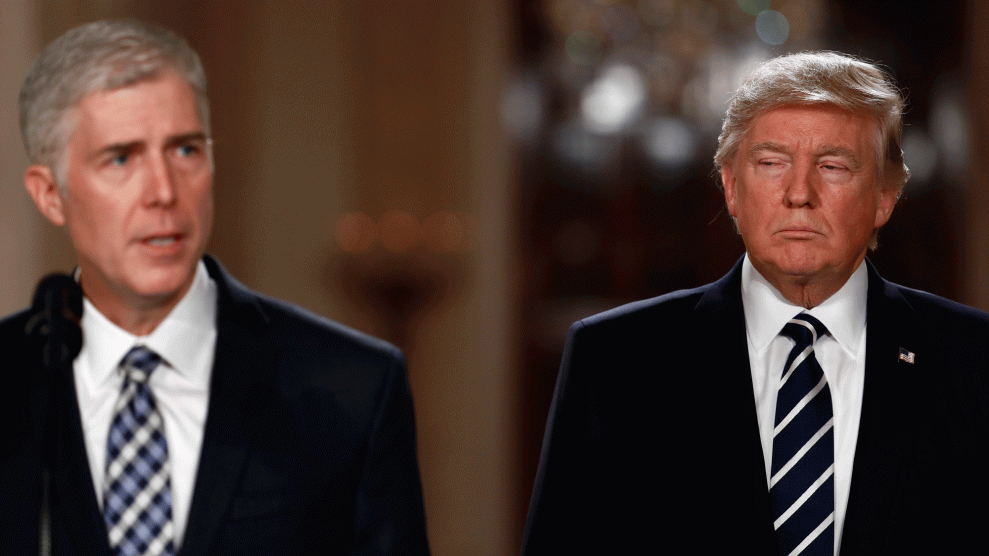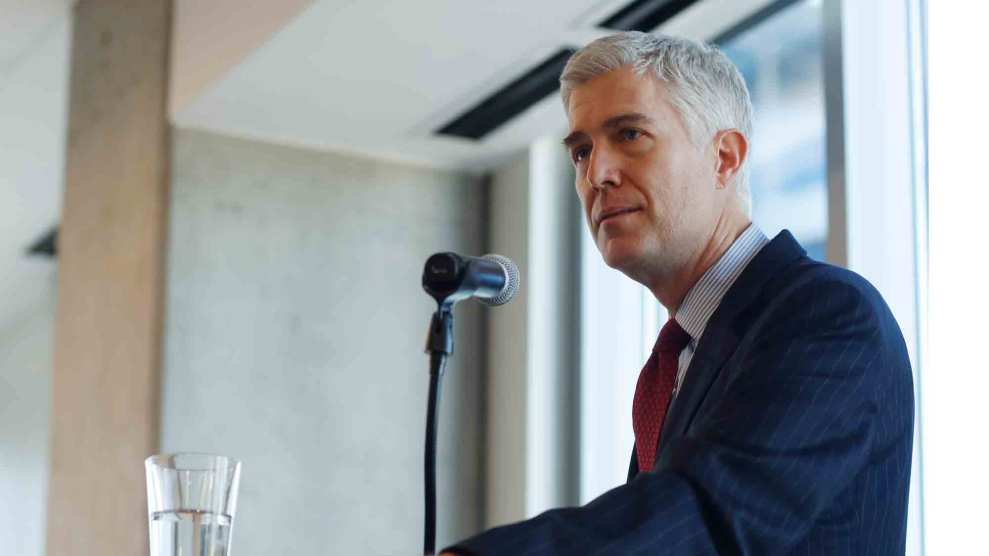Faced with the Trump administration’s assault on regulations, environmental advocates are planning to turn to the courts to limit some of the damage. Green groups are already crafting lawsuits to block any efforts to roll back rules on power plant emissions, vehicle pollution, coal mining, and pipeline permits. Environmentalists have been studying the record of Trump’s Supreme Court nominee, 10th Circuit Court of Appeals Judge Neil Gorsuch, whose Senate confirmation hearings begin Monday. They are trying to understand how he might handle cases on Obama-era climate initiatives, air pollution, and water quality, which may one day end up at the Supreme Court. Chief among their concerns are whether he will even allow them to have their day in court at all.
“He’s not one of those judges who wants to swing the courthouse doors [open] to environmental suits,” says Michael Gerrard, Columbia University Director of the Sabin Center for Climate Change Law. “It would lower their probability for success for those few cases that made it all the way to the Supreme Court.”
When reviewing his record, environmental lawyers have paid a lot of attention to his decisions regarding the weight that should be given to a government agency’s interpretation of the law. Long before Gorsuch was on the federal bench, his mother, then known as Ann Burford, was the head of the Reagan administration’s EPA. A year after Burford resigned from the post, the Supreme Court issued a major decision on her rulemaking, a 1984 opinion establishing the precedent now known as Chevron deference. Under that precedent, courts defer to a government agency’s interpretation of a broad law if Congress did not clearly spell out its intention. Then-Justice John Paul Stevens wrote in the Chevron case that “the Court does not simply impose its own construction on the statute” and instead must defer to the EPA’s interpretation of the Clean Air Act.
That principle has led to a number of government victories in lawsuits. For example, three years ago Chevron deference ultimately led to a Supreme Court win for the EPA on a major air pollution rule. It’s become the basis of the legal argument for many environmental cases since the 1980s, including the Obama administration’s attempts to defend its climate regulations in court. (The D.C. Circuit Court of Appeals is expected to rule on that case soon. It may well end up in the Supreme Court.)
Gorsuch, however, is not a fan of Chevron deference. In a recent opinion, he railed against the Chevron decision which he complained encouraged the executive branch “to swallow huge amounts of core judicial and legislative power and concentrate federal power in a way that seems more than a little difficult to square with the Constitution of the framers’ design. Maybe the time has come to face the behemoth.” Gorsuch would rather see agencies narrowly carry out Congress’ expressed wishes, with judges interpreting exactly what those wishes were.
But there’s another way Gorsuch could deal a huge blow to the environmental community: By preventing their cases from ever getting into court at all. Throughout his career, Gorsuch has found creative ways of throwing judicial roadblocks in front of environmental litigation. In many instances, Gorsuch has ruled that environmentalist groups don’t have what is called “standing” to bring a case. Denise Grab, a senior attorney with the New York University School of Law’s Institute for Policy Integrity, found several examples where Gorsuch went “way beyond what’s the traditional consensus-type views on standing. He’s gone out of his way to take bolder steps than the Supreme Court has taken so far.”
So what exactly is standing? To sue, you have to prove you suffered some kind of harm, which is easy when there are direct economic repercussions, like when someone hits your car. Standing becomes harder to prove if your goal is to protect the planet, but environmentalists can nonetheless make a case on behalf of citizens who are hurt if the law isn’t enforced or is misinterpreted. As Gorsuch puts it, standing is the demonstration that “it’s ‘likely, as opposed to merely speculative,’… you’ve suffered an injury that can be ‘redressed by a favorable decision.'”
Many of the environmental decisions where Gorsuch quibbled on procedural grounds involved public lands disputes. In 2015, for example, the Montana-based public-lands advocates, Backcountry Hunters and Anglers, sued the US Forest Service over a trail management plan that the group said was too lenient for motor vehicles. The merits of the case were never argued in court, because Gorsuch refused to let the case proceed. He reasoned that the plaintiffs couldn’t sue because if they succeeded in overturning the government’s plan, it could actually undermine the group’s interests. In other words, a weaker version of a rule would be better for the plaintiffs than the potential consequences of no rule at all, so weighing the potential costs and benefits, he concluded the group lacked standing to sue.
Here’s what Gorsuch wrote at the time:
[A] victory for Backcountry in this case would seem to do nothing to help—and perhaps much to hurt—its cause…In the end, then, we find ourselves stuck where we started. A further victory for Backcountry in this case promises only more, not fewer, vehicles on forest trails and the group hasn’t offered a timely argument how that turn of events might help its members.
If Gorsuch’s logic were applied to other cases, plenty of environmental arguments would be at risk, says Grab. “Judge Gorsuch’s approach in this case is potentially worrisome to any organization that might want to challenge an agency’s tightening of a regulation as not being comprehensive enough,” she notes in a memo prepared on Gorsuch’s record. “If environmental groups or advocacy groups in general are trying to challenge an agency action as not being sufficient—without getting to court, those issues can not be addressed.”
Gorsuch has also attempted to limit the ability of green groups to defend environmental rules in court. Frequently, these groups seek to intervene in cases—essentially, joining the government as a defendant when regulations they support are being challenged. For example, more than a dozen environmental and public health groups have signed on with states, municipalities, and power companies to defend the EPA’s climate rule restricting coal plant emissions.
In New Mexico Off-Highway Vehicle Alliance v. US Forest Service, Gorsuch dissented from the majority’s decision on whether environmental groups could enter a suit. The off-road drivers’ association had challenged a Forest Service plan limiting where vehicles could go. Gorsuch argued that the Sierra Club, the Center for Biological Diversity, and WildEarth Guardians shouldn’t be allowed to join the case. “There is no actual conflict between the government and the would-be interveners over how to approach it,” he wrote. By adding more complexity to the case, Gorsuch reasoned, “the public’s interest in husbanding limited judicial resources” would be harmed.
That worries Sierra Club managing attorney Joshua Stebbins, who points out the Obama administration enacted a number of key environmental and public health protections. “The Trump administration may, through a number of different mechanisms, elect not to vigorously defend those safeguards before a court,” he says. If that happens, “it would become very important for the public interest community and the public health community to intervene in that lawsuit to make sure the Obama-era safeguards were being defended.”
The Supreme Court hasn’t gone as far as Gorsuch has to limit environmentalists on standing, but he does have a great deal in common with the justice he would replace, Antonin Scalia. “The conservative wing of the court for years has imposed a series of restrictions on standing to sue, and it looks like a Justice Gorsuch would continue in that tradition,” says Columbia University’s Gerrard. However, he doesn’t think Gorsuch would “be any worse” than Scalia was on limiting standing for environmentalists.
Scalia chipped away at standing in environmental cases as far back as 1992, with his opinion in Lujan v. Defenders of Wildlife, when the court ruled that conservationists were unable to prove direct injury in their suit against the government over the Endangered Species Act. The environmental groups in the case “did not demonstrate that they suffered an injury,” he wrote of the case. He mocked the groups’ argument, which he said implied that “anyone with an interest in studying or seeing endangered animals anywhere on the globe” could sue.














